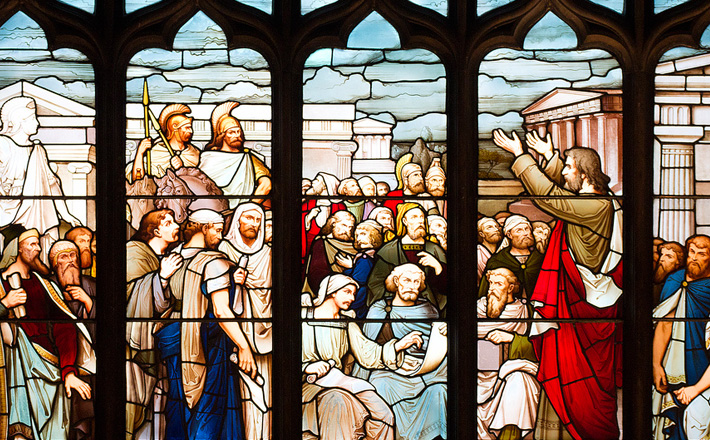Commentary on 1 Peter 3:13-22
The trumpets, the fanfare, and the antiphonal shouts of “He is risen! He is risen, indeed!” have receded into the background.
It is now the sixth Sunday of Easter; by now it may be somewhat difficult to sustain the excitement and positive outlook that only a few short weeks ago seemed so ready at hand. By now we have begun to settle in once again into the drudgery, the lack-luster, the “same-old, same-old” of the mundane daily tasks and worries that characterize life in the real world.
If we recognize any of those sentiments or feelings, then perhaps we can understand in some way what must have been the experience of the recipients of the letter of Peter, living as they were toward the end of the first century. Our distance from the celebration of Easter, even though only a few weeks away, may offer a glimpse of what must have been the experience of this people.
Living now some seventy years after that first Easter event, they can perhaps be forgiven for having difficulty keeping alive the freshness of that first Easter announcement of our Lord’s Resurrection and the accompanying promise of new life in him. But their distance from Easter and the accompanying delay of Christ’s return are not the only problems they face.
The letter makes clear that this community, as it seeks to remain faithful and to live lives that befit a good conscience, is constantly beset by the antagonism and outright persecution of those among whom they live. The double whammy of a fading sense of the resurrection and the very real experience of daily suffering are almost more than they can bear. To such a setting and people the writer addresses a word of encouragement through the restatement and assurances of the promissory implications of Easter.
It perhaps goes without saying, but this people, and perhaps we as well, can afford to hear the announcement reaffirmed once again. No matter what present experience may imply to the contrary, Jesus Christ is Lord. In the reading for today, the writer opens by encouraging his hearers to work against all the signs of intimidation in their lives by keeping the acknowledgement of Christ as their Lord at the center of their hearts (3:15).
In fact this encouraging word is set as a frame around the reading. His words give assurance of Christ’s post-Easter power and authority now marked by his position at the right hand of God, with all the powers of the universe now subject to his authority. To have Christ as Lord is to know that power in life even when all the signs of the surrounding world seem to testify to the contrary.
Every reader of the New Testament is familiar with Paul’s triad of faith, hope, and love, and his remark that the greatest of these is love (1 Corinthians 13). But for the audience of this letter, the more important of these gifts is hope; hope is at risk for those who have difficulty keeping hope alive in the midst of their troubled lives.
So it is both instructive and effective that the letter opens with a beautiful assertion of the blessing of God’s mercy accomplished in the raising of Jesus Christ from the dead and now bestowed on the believers through their “new birth into a living hope.” Not only is this a present and living hope, but it is kept in safety, on deposit as it were, in heaven, and so under God’s faithful protection as an “inheritance” that is “imperishable, undefiled, and unfading” (1 Peter 1:3-5). Again in 1:21 the author appeals to that hope; faith and hope are linked together as grounded in the conviction that God raised Jesus from the dead.
Assertion of that living hope appears at the heart of today’s reading (3:15), indicating how important a theme it is for the whole of 1 Peter. Resurrection and hope belong together. And the hearers are encouraged by a double aspect of this attitude of hope. First, in case the readers are hesitant to believe, there is an implied assumption and with it the assurance that this hope is “in you.” And then, lest that hope be allowed to stagnate without being used, the readers are challenged to be at the ready to “give a defense,” to state in open testimony, that this hope, indeed, dwells in them.
Still, in the midst of all this talk of “hope,” the presenting issue remains the “suffering” that stalks this community. That the author recognizes suffering to be an overwhelming issue for this community is clear from the repeated references to suffering in this letter (twelve explicit uses of the verb suffer out of a total of only forty two in the whole New Testament). The implied complaint is compelling and painful. If God has raised Jesus from the dead, and Jesus Christ is Lord, then why living in the season of Easter do we keep suffering, and especially even when we are “doing what is right.” How can this be justice? Where is the hope in that?
These are not easy questions to answer any more for 1 Peter’s readers than they are for us. The author offers at least two responses. First is the reminder that righteous suffering was modeled in Christ’s own death. On the cross the righteous suffered for the unrighteous, for us; and so our suffering imitates the suffering of Christ and joins us to him. The second is the encouragement, then, to bear this suffering and to continue to do good by not repaying evil treatment with evil. In the midst of suffering you may not be able to control the evil, but you can control how you respond by continuing to do good even in the midst of suffering.
If one asks how it is possible to live in such hope, the answer lies in pointing to the event of baptism. The new birth in the waters of baptism (1:3), just as in the case of Noah and his family, is a sign of God’s protection and salvation because it is linked in its promise to the resurrection — to God’s having raised Jesus from the dead and exalted him to a position of power and authority as the seal of God’s promises (3:21-22).
Several important attributes of character belong to this living hope to which the readers are called and encouraged. Though they are challenged to be able to give an accounting for their hope, that public accounting is to be done with “gentleness and reverence” (3.16). Confidence in hope and in knowing that this hope is grounded in God’s protection and salvation, however correct the theology, does not lead to brow-beating or forceful pressure for submission or agreement.
This is a tough hope that will live as tested only through suffering. The final testimony of the truth of their witness will be seen in their good conduct which will imitate their Lord and will of its own accord put to shame the evil deeds of their adversaries.
Accordingly, twice in the reading the author points to the rewards of a behavior that is guided by this living hope–a good conscience (3:16, 21; see also 2:19). Who can harm you, if you remain eager to do what is good? The words seem to recall somewhat the words of Paul to the Romans: “If we hope for what we do not see, we wait for it with patience…We know that all things work together for good for those who love God…If God is for us, who is against us?” (Romans 8:25, 28, 31)
Even in the midst of suffering, God’s blessing is assured (3:14). Our hope is grounded in the surety that God has raised Jesus from the dead. Christ’s resurrection and the new birth of baptism that joins us both to his suffering and to that resurrection power stands against all signs to the contrary and calls us to good work in the world. This good work has the power to shame every sign of evil that would seek to argue against the love and mercy of God.


May 25, 2014